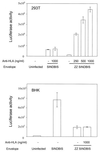Antibody-directed targeting of retroviral vectors via cell surface antigens
- PMID: 11483746
- PMCID: PMC115045
- DOI: 10.1128/jvi.75.17.8016-8020.2001
Antibody-directed targeting of retroviral vectors via cell surface antigens
Abstract
Targeted stable transduction of specific cells is a highly desirable goal for gene therapy applications. We report an efficient and broadly applicable approach for targeting retroviral vectors to specific cells. We find that the envelope of the alphavirus Sindbis virus can pseudotype human immunodeficiency virus type 1- and murine leukemia virus-based retroviral vectors. When modified to contain the Fc-binding domain of protein A, this envelope gives a significant enhancement in specificity in combination with antibodies specific for HLA and CD4 relative to that without antibody. Unlike previous targeting strategies for retroviral transduction, the virus titers are relatively high and stable and can be further increased by ultracentrifugation. This study provides proof of principle for a targeting strategy that would be generally useful for many gene therapy applications.
Figures





References
-
- Ager S, Nilson B H, Morling F J, Peng K W, Cosset F L, Russell S J. Retroviral display of antibody fragments; interdomain spacing strongly influences vector infectivity. Hum Gene Ther. 1996;7:2157–2164. - PubMed
-
- Camerini D, Seed B. A CD4 domain important for HIV-mediated syncytium formation lies outside the virus binding site. Cell. 1990;60:747–754. - PubMed
Publication types
MeSH terms
Substances
Grants and funding
LinkOut - more resources
Full Text Sources
Other Literature Sources
Research Materials

